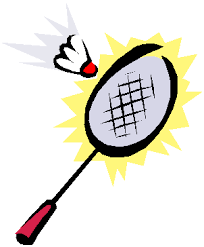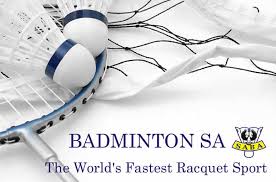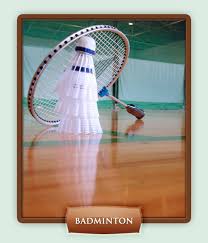



About five centuries later, a game named Battledore and Shuttlecock was played in china, Japan, India and Greece. This is a game where you use the Battledore (a paddle) to hit the Shuttlecock back and forth. By the 16th century, it has become a popular game among children in England. In Europe this game was known as jeu de volant to them. In the 1860s, a game named Poona was played in India. This game is much like the Battledore and Shuttlecock but with an added net. The British army learned this game in India and took the equipments back to England during the 1870s.
In 1873, the Duke of Beaufort held a lawn party in his country place, Badminton. A game of Poona was played on that day and became popular among the British society's elite. The new party sport became known as "the Badminton game". In 1877, the Bath Badminton Club was formed and developed the first official set of rules.
The International Badminton Federation (IBF) was formed in 1934 with 9 founding members.
- England
- Ireland
- Scotland
- Wales
- Denmark
- Holland
- Canada
- New Zealand
- France
Since then, major international tournaments like the Thomas Cup (Men) and Uber Cup (Women) were held.Badminton was officially granted Olympic status in the 1992 Barcelona Games. From 9 founding members, IBF now have over 150 member countries. The future of Badminton looks bright indeed.
Badminton court
The Badminton Court Diagram above fully illustrates the standard Badminton Court Layout.
The Badminton Court shall be a rectangle laid out with lines of 40mm wide, preferably in white or yellow color. The Badminton Court Dimensions are of 13.4m in length and 6.1m in width. The post shall be 1.55m in height from the surface of the court and shall remain vertical when the net is strained. The net shall be made of fine cord of dark color and even thickness with a mesh of not less than 15mm and not more than 20mm. The net shall be 760mm in depth and at least 6.1m wide.
The top of the net shall be edged with a 75mm white cloth. The top of the net from the surface of the court shall be 1.524m (5ft) at the centre of the court and 1.55m (5ft 1in) over the side lines for doubles. There shall be no gaps between the ends of the net and the posts. If necessary, the full depth of the net should be tied at the ends.
The recommended surface for a badminton court is wood and bituminous material. Avoid concrete or carpet as playing on it will easily injure you.
The indoor badminton court

The outdoor badminton court

Requirement for badminton players
The players were instructed to react to the flashes by running towards them, and striking shuttles mounted in the vicinity of the bulbs. Exercise intensity was controlled by altering the interval between successive lighting's. A low correlation (r = 0.65) was found between the results of the field test and the rank-order list of subjects, based on an objective on-field physiological assessment and subjective ranking. This may be explained by the requirements of other factors besides physical fitness which contribute to success in elite level badminton competition. These factors may include, for example, technical skill, mental power, and aesthetic judgements on the court. Maximum mean (s.d.) heart rate data (187(8) beats.min-1) and blood lactate values (10.4(2.9) mmol.l-1) in this study showed that players were under maximal load during the field test. From the testing data, it seems reasonable to speculate that the intensity of level 3 (20 light pulses.min-1; 3.0 s.pulse-1) and level 4 (22 light pulses.min-1; 2.7 s.pulse-1) simulates the requirement of actual games energy expenditure of the badminton players exercising at close to their anaerobic threshold. The results also show that an estimate of fitness can be derived from measurements involving exercise closely resembling that which is specific for the sports activity in question. Improved training advice and guidance may result from such studies.
Badminton equipments
Badminton Racket
 A badminton racket shall not exceed 680mm in overall length and 230 mm in overall width.
A badminton racket shall not exceed 680mm in overall length and 230 mm in overall width.
How to choose a Badminton Racket that suits you most?
Heavier rackets are mostly preferred by players who have much stronger wrists and can therefore make use of the weight of the racket to extract more power from it. So unless you are in this category, I would suggest you purchase one that is not too heavy.
The weight should not exceed more than 100 grams.
A majority of racket manufacturers use 1U, 2U, 3U, 4U to indicate the weight of the racket, 1U being the heaviest and 4U the lightest. The weight of high quality rackets range from 83 grams to 100 grams.
Most racket manufacturers provide four grip sizes. In Japan, they range from G2, G3, G4 to G5 where G2 is the biggest size and G5 is the smallest size. In some countries, the opposite applies. Some brands go by small, medium and big sizes.
Choose a grip size that you feel comfortable with. Generally, attacking players prefer bigger grips as they need to hold the racket more tightly to generate power.
Players who like to rally and make use of deception usually prefer a smaller grip so that the racket is easier to turn in their hands.
Buy a head-cover with your racket, and use it whenever you are not playing. Remember not to store your racket close to the central heating radiators, or leave it exposed to sunlight inside a car.
Shuttle Cock
 A Shuttle cock shall have 16 feathers fixed in a cork base covered in kid leather. Interestingly, the best Badminton Shuttlecocks are made from feathers from the left wing of a goose.
A Shuttle cock shall have 16 feathers fixed in a cork base covered in kid leather. Interestingly, the best Badminton Shuttlecocks are made from feathers from the left wing of a goose.
The feathers shall be measured from the tip to the top of the base and each shuttle shall be of the same length. This length can be between 62mm and 70mm.The shuttle shall weigh between 4.74 to 5.50 grams.
 A good pair of Badminton Shoes must provide good grip, cushioning and some flexibility at the forefoot.
A good pair of Badminton Shoes must provide good grip, cushioning and some flexibility at the forefoot. In this Badminton Accessory category, I have grouped five items under it. They are Grip, Clothes, Socks, Wrist Band and Head Band.
In this Badminton Accessory category, I have grouped five items under it. They are Grip, Clothes, Socks, Wrist Band and Head Band.Grip
You can choose to use either a towel grip or a synthetic one. Both serve the same purpose, which is to absorb sweat and provide you a drier feel.
Clothes
Always wear shirts and shorts that are comfortable and will not hinder your movements. I usually wear a cotton round-neck or a collar t-shirts with a pair of light shorts.
Socks
Wear a pair of thick cotton socks as they help to absorb sweat. It will prevent your feet from slipping inside your shoes. Nylon socks can stretch and provide good fit but are not suitable for badminton as they can't absorb much sweat.
Wrist Band
It will prevent your sweat from flowing to your racket handle.
Head Band
Wear a Head Band if you are wearing spectacles. It will prevent your lenses from getting wet. Head Bands will also stop the sweat from getting into your eyes.
The rules of badmintonToss
The rules of badminton states that a toss shall be conducted before a game starts. If you win, you can choose between serving first or to start play at either end of the court. Your opponent can then exercise the remaining choice.
Scoring system
The rules of badminton states that a badminton match shall consist of the best of 3 games. In doubles and men's singles, the first side to score 15 points wins the game. In women's singles, the first side to score 11 points wins the game.
If the score becomes 14-all (10-all in women's singles), the side which first scored 14 (10) shall exercise the choice to continue the game to 15 (11) points or to 'set' the game to 17 (13) points.
The side winning a game serves first in the next game. Only the serving side can add a point to its score.
Recently IBF have been testing a new scoring format of 21 points per game on all major Badminton competition and decided to replace the old format permanently.
Change of ends
The rules of badminton states that you have to change ends with your opponent after finishing the firstgame. If a third game was to be played, you shall change ends when the leading score reaches 6 in agame of 11 points or 8 in a game of 15 points.
New badminton 21 scoring system
For Singles matches, the rules are:
-A match consists of best of 3 games.
-The side that first scored 21 points shall win.
-The side winning a rally shall add 1 point to its score.
-If a score becomes 20-20, the side which scores 2 consecutive points shall win that game.
-If the score becomes 29-29, the side that scores the 30th point shall win that game.
-The side winning a game serves first in the next game.
-When one side reaches 11 points, both players get a 60 second break.
-Both sides get a 2-minute break between first and second games, and another 2-minute break between second and third game.
-Other rules shall remain the same.
For Doubles matches, the rules are:
-One service only
-Back service line remains and the current rule applies.
The chart below explains the 3x21 rally point scoring system for doubles matches.
In a Doubles match between A&B against C&D. A&B win the toss and decide to serve. A will serve to C. A shall be the initial server while C shall be the initial receiver.
Course of Action/ Explanation
Score
. . Service from Service Court
Server & Receiver
Winner of the Rally
.
Love All
C
D
Right service court. Being the score of the serving side is even.
A serves to C. A and C are the initial server and receiver.
A & B
B
A
A & B win a point. A & B will change service courts. A serves again from Left service court. C & D will stay in the same service courts.
1-0
C
D
Left service court. Being the score of the serving side is odd.
A serves to D
C & D
A
B
C & D win a point and also right to serve. Nobody will change their respective service courts.
1-1
C
D
Left service court. Being the score of the serving side is odd.
D serves to A
A & B
A
B
A & B win a point and also right to serve. Nobody will change their respective service courts.
2-1
C
D
Right service court. Being the score of the serving side is even.
B serves to C
C & D
A
B
C & D win a point and also right to serve. Nobody will change their respective service courts.
2-2
C
D
Right service court. Being the score of the serving side is even.
C serves to B
C & D
A
B
C & D win a point. C & D will change service courts. C serves from Left service court. A & B will stay in the same service courts.
3-2
D
C
Left service court. Being the score of the serving side is odd.
C serves to A
A & B
A
B
A & B win a point and also right to serve. Nobody will change their respective service courts.
3-3
D
C
Left service court. Being the score of the serving side is odd.
A serves to C
A & B
A
B
A & B win a point. A & B will change service courts. A serves again from Right service court. C & D will stay in the same service courts.
4-3
D
C
Right service court. Being the score of the serving side is even.
A serves to D
C & D
B
A
(for the full chart,visit http://www.badminton-information.com/badminton_21_points.html )CreditsGoogle, badminton information website Done by : Lee Xiao Yu (12) :) 
Socks
Wrist Band
Toss
Scoring system
If the score becomes 14-all (10-all in women's singles), the side which first scored 14 (10) shall exercise the choice to continue the game to 15 (11) points or to 'set' the game to 17 (13) points.
The side winning a game serves first in the next game. Only the serving side can add a point to its score.
Recently IBF have been testing a new scoring format of 21 points per game on all major Badminton competition and decided to replace the old format permanently.
Change of ends
-A match consists of best of 3 games.
-The side that first scored 21 points shall win.
-The side winning a rally shall add 1 point to its score.
-If a score becomes 20-20, the side which scores 2 consecutive points shall win that game.
-If the score becomes 29-29, the side that scores the 30th point shall win that game.
-The side winning a game serves first in the next game.
-When one side reaches 11 points, both players get a 60 second break.
-Both sides get a 2-minute break between first and second games, and another 2-minute break between second and third game.
-Other rules shall remain the same.
-One service only
-Back service line remains and the current rule applies.
The chart below explains the 3x21 rally point scoring system for doubles matches.
In a Doubles match between A&B against C&D. A&B win the toss and decide to serve. A will serve to C. A shall be the initial server while C shall be the initial receiver.
Course of Action/ Explanation | Score | . | . | Service from Service Court | Server & Receiver | Winner of the Rally |
. | Love All | C | D | Right service court. Being the score of the serving side is even. | A serves to C. A and C are the initial server and receiver. | A & B |
B | A | |||||
A & B win a point. A & B will change service courts. A serves again from Left service court. C & D will stay in the same service courts. | 1-0 | C | D | Left service court. Being the score of the serving side is odd. | A serves to D | C & D |
A | B | |||||
C & D win a point and also right to serve. Nobody will change their respective service courts. | 1-1 | C | D | Left service court. Being the score of the serving side is odd. | D serves to A | A & B |
A | B | |||||
A & B win a point and also right to serve. Nobody will change their respective service courts. | 2-1 | C | D | Right service court. Being the score of the serving side is even. | B serves to C | C & D |
A | B | |||||
C & D win a point and also right to serve. Nobody will change their respective service courts. | 2-2 | C | D | Right service court. Being the score of the serving side is even. | C serves to B | C & D |
A | B | |||||
C & D win a point. C & D will change service courts. C serves from Left service court. A & B will stay in the same service courts. | 3-2 | D | C | Left service court. Being the score of the serving side is odd. | C serves to A | A & B |
A | B | |||||
A & B win a point and also right to serve. Nobody will change their respective service courts. | 3-3 | D | C | Left service court. Being the score of the serving side is odd. | A serves to C | A & B |
A | B | |||||
A & B win a point. A & B will change service courts. A serves again from Right service court. C & D will stay in the same service courts. | 4-3 | D | C | Right service court. Being the score of the serving side is even. | A serves to D | C & D |
B | A |

No comments:
Post a Comment